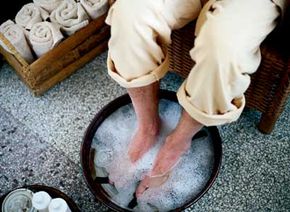You may refer to your feet as tootsies or dogs, but the fact remains that feet are highly sophisticated structures. The human foot is a miracle of engineering, designed to stand up under a lot of wear and tear. It's a good thing, too, since your feet are the most used and abused parts of your body. According to the American Podiatric Medical Association, the average American walks 115,000 miles in a lifetime, a distance that would take you all the way around the earth four times. Your feet support the weight of your body, clothing, and whatever extras you might be carrying. And in an average day of walking, your feet are subjected to a force equal to several hundred tons.
Despite how well designed your feet are, however, things can go wrong. In fact, an estimated 87 percent of all American adults have some type of foot problem. Among the most common of these problems are corns and calluses, which are patches of toughened skin that form to protect sensitive foot tissue against repeated friction and pressure. This article will provide home remedies to alleviate the pain of corns and calluses, as well as some suggestions for preventing them. Let's begin with some general information about the affliction.
Advertisement
The main function of calluses and corns is protecting sensitive areas on the foot. Corns come in two varieties: hard and soft. Hard corns are usually found on the tops of the toes or on the outer sides of the little toes, where the skin rubs against the shoe. Sometimes, a corn will form on the ball of the foot beneath a callus, resulting in a sharp, localized pain with each step. Soft corns, which are moist and rubbery, form between toes, where the bones of one toe exert pressure on the bones of its neighbor. Both hard and soft corns are cone shaped, with the tip pointing into the foot (what you see is the base of the cone). When a shoe or another toe puts pressure against the corn, the tip can hit sensitive underlying tissue, causing pain.
Unlike corns, calluses generally form over a flat surface and have no tip. They usually appear on the weight-bearing parts of the foot: the ball or the heel. As people age, the padding on the bottom of the foot begins to thin, so calluses naturally develop to protect the foot from too much pressure and chafing. Each step presses the callus against underlying tissue, and that may cause aching, burning, or tenderness but rarely sharp pain.
Mistreating the feet by wearing shoes that don't fit well or that are too inflexible or nonporous are common causes of calluses and corns. Shoes that squeeze the toes force one toe to rub against the other, ultimately causing a corn to develop. High-heeled shoes also are major culprits, since they put pressure on the front of the foot, as can ill-fitting socks or irritation from your foot rubbing against a sock seam or shoe stitching. Shoes that are too loose cause your foot to slide, creating friction that can cause calluses.
- Walking on hard surfaces.
- Having flat feet (people with flat feet are more likely to get calluses).
- Thinning of the skin on the sole of the foot.
- Being diabetic. Diabetics and others with circulatory problems should never self-treat or ignore foot problems.
In the next section, we'll offer soothing home remedies to get you back on your feet in no time.
For more information on foot problems and home remedies to treat them, try the following links:
- To see all of our home remedies and the conditions they treat, go to our main Home Remedies page.
- For self-help tips on relieving the sting of athlete's foot, read Home Remedies for Athlete's Foot.
- Home Remedies for Foot Odor offers a number of simple measures to keep your feet odor-free.
- If painful feet are causing you concern, go to Home Remedies for Foot Pain to learn more.
This information is solely for informational purposes. IT IS NOT INTENDED TO PROVIDE MEDICAL ADVICE. Neither the Editors of Consumer Guide (R), Publications International, Ltd., the author nor publisher take responsibility for any possible consequences from any treatment, procedure, exercise, dietary modification, action or application of medication which results from reading or following the information contained in this information. The publication of this information does not constitute the practice of medicine, and this information does not replace the advice of your physician or other health care provider. Before undertaking any course of treatment, the reader must seek the advice of their physician or other health care provider.
But socks and shoes aren't the only causes of corns and calluses. You can also get them from:
Advertisement


